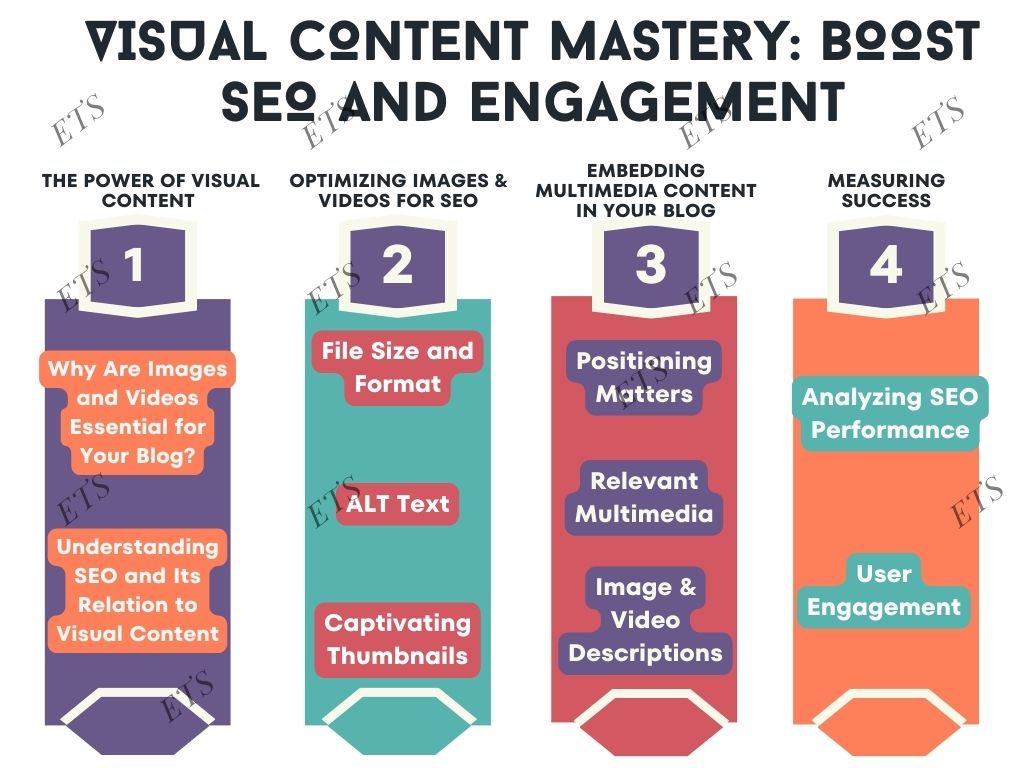Visual Content Mastery: Using Images and Videos Effectively to Rank Your Blogs on Search Engines and Engage Users Better
In the digital age, content is king, and blogging has become a powerful tool for sharing knowledge, promoting businesses, and connecting with an audience. However, with the vast amount of content available online, it’s crucial to find innovative ways to stand out. One of the most effective methods for improving your blog’s visibility and engaging your audience is by using images and videos strategically. In this article, we’ll explore how you can leverage multimedia content to enhance your blog’s SEO and captivate your readers.
Elevating Your Visual Content Mastery
Strategies for Visual Content Mastery
The Power of Visual Content
Why Are Images and Videos Essential for Your Blog?
Images and videos are essential components of a successful blog for several reasons:
- Enhanced Engagement: Visual content captures the audience’s attention and keeps them on your page longer.
- Improved Understanding: Complex concepts are easier to explain with visuals.
- Better SEO: Search engines love multimedia content.
Understanding SEO and Its Relation to Visual Content
Search Engine Optimization (SEO) is the practice of optimizing your content to rank higher in search engine results. When it comes to visual content, here’s how it can boost your SEO:
1. Image Optimization
When using images, make sure to:
- Choose high-quality images that are relevant to your content.
- Compress images to reduce load times.
- Use descriptive filenames and ALT text.
2. Video SEO
For videos, consider:
- Creating engaging video titles.
- Writing detailed video descriptions.
- Using relevant keywords and tags.
Optimizing Images and Videos for SEO
File Size and Format
Optimizing images for SEO involves reducing file size without compromising quality. This is essential to improve page load times and user experience. JPEG and PNG formats are ideal for most images.
ALT Text
Alternative text (ALT text) is a crucial element for image SEO. It provides a textual description of the image, making it accessible to visually impaired users and helping search engines understand the content.
Captivating Thumbnails
For videos, captivating thumbnails encourage more clicks. A visually appealing thumbnail can make a significant difference in user engagement.
Embedding Multimedia Content in Your Blog
The Art of Mastering Visual Content
Positioning Matters
Consider where you place images and videos within your content. Strategic positioning can enhance the user experience and encourage readers to explore more.
Relevant Multimedia
Images and videos should always align with your blog’s content. Irrelevant multimedia can confuse or deter readers.
Image and Video Descriptions
When incorporating multimedia, provide brief but informative descriptions to give context to your audience.
Measuring Success in Visual Content Mastery
Analyzing SEO Performance
Use tools like Google Analytics to monitor the impact of visual content on your blog’s performance. Track metrics such as page views, bounce rate, and time spent on page.
User Engagement
Pay attention to comments, shares, and likes on your blog. High engagement indicates that your multimedia content is resonating with your audience.
Conclusion
Incorporating images and videos effectively into your blog can significantly boost your SEO rankings and engage your audience better. Remember to optimize your multimedia content, position it strategically, and monitor its impact to ensure your blog’s success.
FAQs
1. What is the ideal image file size for a blog post?
For optimal blog performance, aim for image file sizes between 100KB and 250KB. This balance ensures good quality while minimizing page load times.
2. How can I find the right keywords for my video content?
Keyword research tools like Google Keyword Planner or SEMrush can help you identify relevant keywords for your video content. Focus on long-tail keywords for better targeting.
3. Should I create my visuals or use stock images and videos?
Both options can be viable. Creating your visuals offers uniqueness, but stock images and videos can save time and resources. Choose based on your specific needs.
4. How often should I update my blog with new visual content?
Frequent updates with relevant visuals can positively impact your blog. Aim for at least one visual element per blog post, and consider updating old content with new multimedia.
5. What’s the best way to encourage user engagement with visual content?
To engage users effectively, encourage them to interact with your multimedia. Ask questions in your content, invite comments
Visit our Channel for more useful videos:
Scroll to Top
Visual Content Mastery: Boost SEO and Engagement
